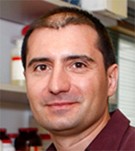
Nansen Neuroscience Lecture 2015
Dette foredraget er en del av Nansen minneforelesning. For å lese mer om arrangementet om pol-isen, se arrangementet:
-
Forelesning ved professor Yngve Kristoffersen, Universitetet i Bergen.
--------------------------------------
In the center of your brain are the ‘basal ganglia'. You use them all the time to select which actions to take. How can the basal ganglia learn to string together a sequence of motor actions to accomplish a goal, and how does this process get awry in disease?
About the Nansen Neuroscience Lecture:
The Nansen Neuroscience Lectures (NNL) are organized in conjunction with Fridtjof Nansen's birthday to commemorate his fundamental contribution to neuroscience. The NNL are given by speakers selected from the top tier of neuroscience research.
Admission: open to public, no charge
Programme:
- 11:30 – 12:00 Coffee and refreshments, mingling
- 12:00 – 12:03 Opening by Kirsti Strøm Bull, President of The Norwegian Academy of Science and Letters
- 12:03 – 12:06 Introduction by Linda H. Bergersen, University of Oslo
- 12:06 – 12:46 Lecture by Bernardo L. Sabatini, Harvard University
- 12:46 – 13:00 Discussion and questions from the audience, moderator Jon Storm-Mathisen
Abstract
Neurons communicate via specialized contact points called synapses at which neurotransmitters are released and activate specific receptor proteins. Synaptic activity is responsible for transmitting information throughout the brain and regulation of synapses is thought to be the biological substrate underlying learning and memory formation. Here we present recent data from our laboratory on the nature of neurotransmission in the basal ganglia, a phylogenetically old and evolutionarily conserved brain area that mediates coordinated and goal-oriented motor action. In humans, dysfunction of the basal ganglia underlies many neuropsychiatric disorders such as Parkinson¹s, Tourette¹s, drug addiction, and Huntington's. We find that synapses within this region have unique cell biological and signaling properties such that they target distinct neuronal populations with different neurotransmitters. Our findings reveal an additional level of complexity in neuronal cell biology and network organization with crucial implications for the treatment of human disease.
Biography: Bernardo Sabatini
Professor Bernardo Sabatini is based at Harvard Medical School, and is also a Howard Hughes Medical Institute ﴾HHMI﴿ Investigator. His laboratory seeks to uncover the mechanisms of synapse and circuit plasticity that permit new behaviors to be learned and refined. They are interested in the developmental changes that occur after birth that make learning possible as well as in the circuit changes that are triggered by the process of learning. Lastly, they examine how perturbations of these processes contribute to human neuropsychiatric disorders such as Tuberous Sclerosis Complex and Parkinson's disease.
Organizers
Linda H Bergersen and Jon Storm-Mathisen in cooperation with the University of Oslo, the Nansen Neuroscience Network (NNN), and the Norwegian Academy of Science and Letters (DNVA).